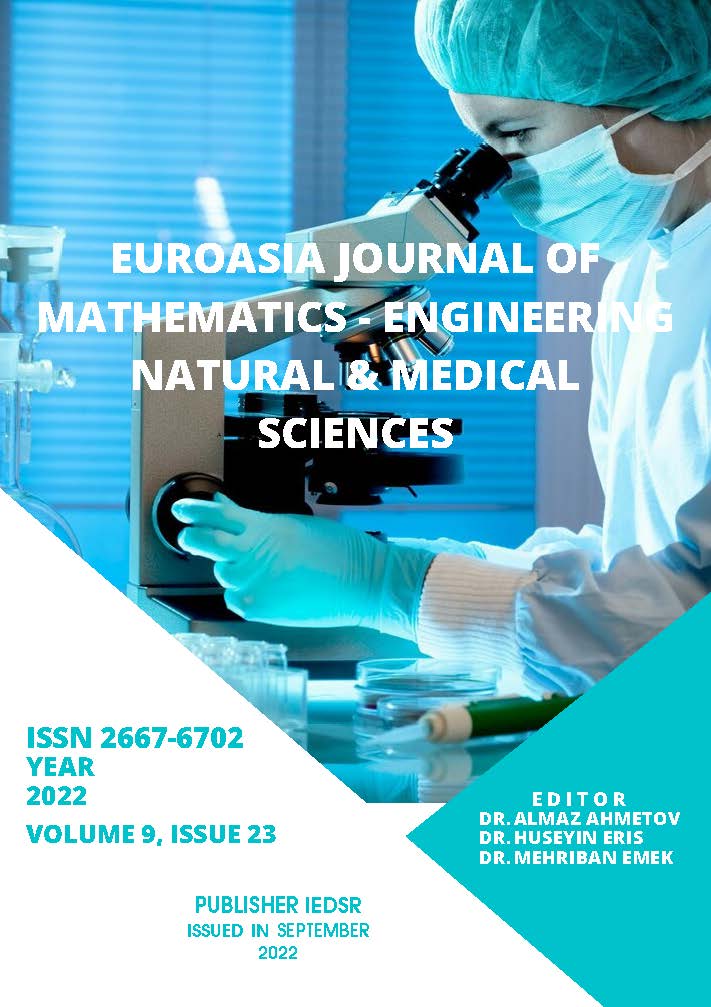Bioremediation of Crude Oil Contaminated Soils Using Agricultural Wastes
DOI:
https://doi.org/10.5281/zenodo.7130663Keywords:
Crude oil, soil pollution, agricultural waste, remedition methods, remediation methodsAbstract
Soil pollution is defined as the accumulation of persistent toxic compounds, chemicals, salts, radioactive substances or disease-causing substances in the soil that have adverse effects on plant growth and animal health. Soil polluting resources can be divided into two groups as agricultural resources and non-agricultural resources. Petroleum pollution endanger the living life in the environment, causes extinction of some species, pollution of underground and surface resources, can cause fire hazard with the evaporation of the volatile components in its structure, thus disrupting the ecological balance of nature. Therefore, it is important to clean the contaminated areas. This study was undertaken with the aim of rehabilitating soils contaminated with crude oil by using agricultural wastes for various purposes. For this purpose, crude oil pollution in the soil was created artificially in the laboratory by mixing soil and crude oil at a ratio of 10:1. In the studies, trials were established by using chicken manure, rice husk, barn manure and sawdust from agricultural wastes in order to eliminate crude oil pollution. For identification of total petroleum hydrocarbons (TPH) and trace of heavy metals namely (Zn, Cd and Co) in the crude oil contaminated samples. Each samples was mixed with sawdust (30g), chicken manure + wood sawdust (22.5 g +22.5g), chicken manure (30g), barn manure (30 g) and rice husk (30g) the results indicated that rice husk ultimately removed more petroleum hydrocarbons compared to chicken manure and their combinations. It was also found that the combination of rice husk and chicken manure reduced 75.5% of CO concentration, reduced 75.5% of Zn concentration, and reduced 75.5% of Cd concentration.
References
Abbasian, F., Lockington, R., 2015. A Comprehensive Review of Aliphatic Hydrocarbon Biodegradation by Bacteria. Appl. Biochem. Biotechnol. 3, 670–699. https://doi.org/10.1007/s12010-015-1603-5
Hamoudi-belarbi, L., Hamoudi, S., Belkacemi, K., Nouri, L.H., 2018. Bioremediation of Polluted Soil Sites with Crude Oil Hydrocarbons Using Carrot Peel Waste. Environments 5, 124. https://doi.org/10.3390/environments5110124
Khudur, L.S., Shahsavari, E., Miranda, A.F., Morrison, P.D., Nugegoda, D., Ball, A.S., 2015. Evaluating the efficacy of bioremediating a diesel-contaminated soil using ecotoxicological and bacterial community indices. Environ. Sci. Pollutıon Res. 22, 14809–14819. https://doi.org/10.1007/s11356-015-4624-2
Lim, M.W., Lau, E. Von, Poh, P.E., 2016. A comprehensive guide of remediation technologies for oil contaminated soil — Present works and future directions. Mar. Pollut. Bull. 109, 14–45. https://doi.org/10.1016/j.marpolbul.2016.04.023
Manufacturing, P., This, E.B. V, By-nc-nd, C.C., This, E.B. V, By-nc-nd, C.C., 2017. Bioremediation of Crude Oil Contaminated Soil Using Agricultural Wastes. Procedia Manuf. 7, 459–464. https://doi.org/10.1016/j.promfg.2016.12.037
Park, I., Park, J., 2011. Determination of a risk management primer at petroleum-contaminated sites : Developing new human health risk assessment strategy. J. Hazard. Mater. 185, 1374–1380. https://doi.org/10.1016/j.jhazmat.2010.10.058
Petroleum, T., Criteria, H., Group, W., 1998. Analysis of Petroleum Hydrocarbons in Environmental Media Analysis of Petroleum Hydrocarbons in Environmental Media.
Pinedo, J., Ibáñez, R., Lijzen, J.P.A., Irabien, Á., 2013. Assessment of soil pollution based on total petroleum hydrocarbons and individual oil substances. J. Environ. Manage. 130, 72–79. https://doi.org/10.1016/j.jenvman.2013.08.048
Rizzo, A.C.D.L., Ronaldo, L.C., Soriano, A.U., Cunha, D., Rosado, A.S., Luis, G., Sobral, S., Leite, S.G.F., 2010. Petroleum-contaminated soil remediation in a new solid phase bioreactor. J. Chem. Technol. Biotechnol. 85, 1260–1267. https://doi.org/10.1002/jctb.2425
Ron, E.Z., Rosenberg, E., 2014. ScienceDirect Enhanced bioremediation of oil spills in the sea. Curr. Opin. Biotechnol. 27, 191–194. https://doi.org/10.1016/j.copbio.2014.02.004
Schmidt, I.K., Shaver, G.R., 2004. NITROGEN UPTAKE BY ARCTIC SOIL MICROBES AND PLANTS IN. Ecol. Soc. Am. 85, 955–962.
Todd, G.D., Chessin, R.L., Colman, J., 1999. TOXICOLOGICAL PROFILE FOR TOTAL PETROLEUM HYDROCARBONS ( TPH ).
Varjani, S.J., 2015. Microbial degradation of petroleum hydrocarbons. Bioresour. Technol. 223, 277–286. https://doi.org/10.1016/j.biortech.2016.10.037
Xu, R., 2012. Bioremediation of petroleum contaminated soil. Adv. Mater. Res. 550–553, 1248–1252. https://doi.org/10.4028/www.scientific.net/amr.550-553.1248
Zhao, J., Gui, L., Wang, Q., Liu, Y., Wang, D., Ni, B., 2017. Aged refuse enhances anaerobic digestion of waste activated sludge. Water Res. 123, 724–733. https://doi.org/10.1016/j.watres.2017.07.026
Downloads
Published
How to Cite
Issue
Section
License
Copyright (c) 2022 Euroasia Journal of Mathematics, Engineering, Natural & Medical Sciences

This work is licensed under a Creative Commons Attribution-NonCommercial 4.0 International License.


